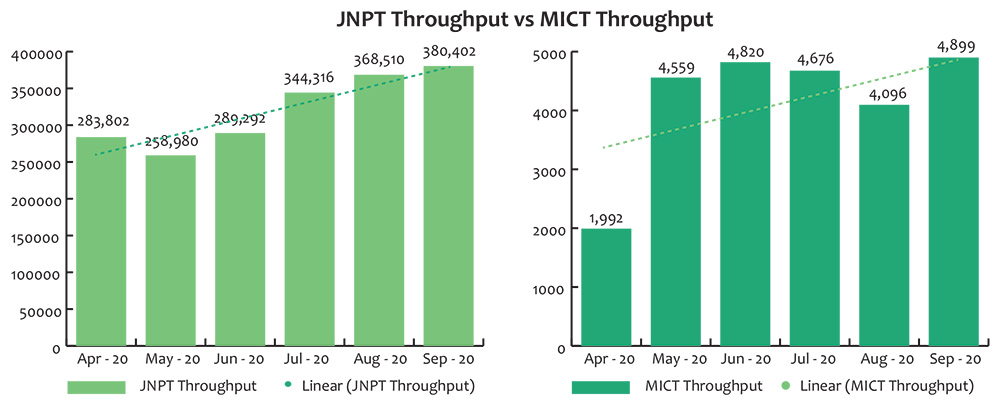JNPT is on the path to normality with regards to volumes. Operationally, JNPT has always been at the forefront, which continued during the lockdown. JNPT is the country’s largest port in terms of containerised cargo. It handled approximately 80 per cent of the total traffic in comparison to the same period last year.
The unlocking started in June 2020 in Maharashtra, and since then, exports have increased. In fact, export volumes have already attained normalcy. This has helped JNPT, as well, in terms of realising a positive overall throughput. With export consignments gradually picking up, JNPT is now adjusting to the new normal, as cargo volumes recover month after month. Imports too are increasing. The comparison between Q1 and Q2 volumes bears testimony to the same. JNPT volumes have consistently been on a growth trajectory since April. In the second quarter of financial year 2021, JNPT performed much better than in Q1.
Due to the unlocking of restrictions, the gap between imports and exports narrowed rapidly and returned to its usual position in September 2020. Overall volumes are looking up. China loadings are currently increasing. Ocean freight for Europe, the Far East and the Gulf has also increased.
In fact, many manufacturing units are shifting from China to Malaysia, Bangladesh, Indonesia and other smaller developing countries with trade-friendly policies. Traffic is also coming from Taiwan and Singapore as well. Thus, overall volumes are expected to increase, as there is a pent-up demand that needs to be fulfilled. Volumes are expected to bounce back completely in 2 or 3 months.
In summary, JNPT is constantly evolving and returning to normalcy.
MICT, also a part of J M BAXI GRO U P, continues to remain amongst the top-performing CFSs in Nhava Sheva. Q1 and Q2 volumes have remained subdued as industrial activities in the InfrastructureNovember 2020Newsletter Issue XXXIIlocal hinterland are reviving slowly. Despite the Covid-induced delays and skipping of Nhava Sheva by the main lines, MICT volumes still grew by 20%. They increased from 11,371 TEU in Q1 to 13,671 TEU in Q2, whereas JNPT had a 31% increase in throughput, from 832,074 TEU in Q1 to 1,093,228 TEU in Q2. Exports from JNPT were extremely strong, but due to limited space, MICT could average only 600 TEU a month.
In Q2, base import products, like chemicals, machinery and food, restarted. Reefer imports of confectionery, dairy products and fruit and are expected to peak by November.
To offer a full range of services to end customers, MICT is developing a cold store, a bonded and general warehouse, and an open bond facility at MICT-2, which should be ready early next year.
Volumes at MICT are also showing an upward trend, like JNPT, as depicted in the graph.
